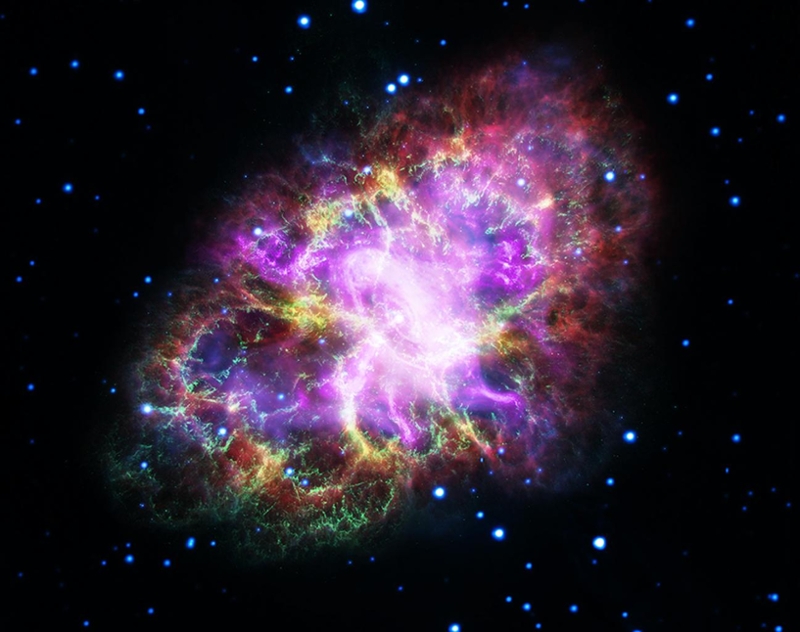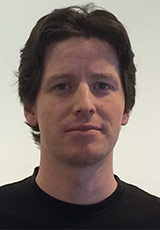UNB researcher awarded editor’s choice recognition for quantum gravity article
Author: UNB Research
Posted on Feb 19, 2021
Category: Research , Publications , Accolades

Banner image: NASA image of the Crab Nebula, which was formed by a star going supernova, that combines data from five different telescopes. Read more about the nebula on NASA's site.
Dr. Edward Wilson-Ewing is one of three authors of a paper titled, “Resolving the H0
tension with diffusion,” published in General Relativity and Gravitation 53, 7, that recently received the issue’s Editor’s Choice designation from the journal.
We asked him to tell us a bit about himself, and the research involved in that article.
Before we jump into that, however, Dr. Sanjeev Seahra, professor and department chair of mathematics and statistics, provided a comment celebrating this paper:
“The mysterious discrepancy between different measurements of the expansion rate of the universe is one of the most perplexing problems in modern cosmology. It may very well be that the source of the problem is some sort of exotic new physics, and Dr. Wilson-Ewing's work provides an interesting example of how this might work. I congratulate him and his co-authors on this well-deserved recognition!”
Congratulations, indeed!
Now, let’s get Dr. Wilson-Ewing to help us better understand what exactly these “exotic new physics” are.
Who are you?
 My name is Dr. Edward Wilson-Ewing, and I’m an associate professor of mathematics and statistics at UNB in Fredericton.
My name is Dr. Edward Wilson-Ewing, and I’m an associate professor of mathematics and statistics at UNB in Fredericton.
I work in theoretical physics on the problem of quantum gravity; our main goal is to reconcile the theories of quantum mechanics and general relativity – a theory called “quantum gravity.”
I am particularly interested in studying the role that quantum gravity effects may have in the very early universe and in black holes.
I obtained my PhD from the Pennsylvania State University, and was a postdoctoral fellow at Aix-Marseille University, Louisiana State University, and the Max Planck Institute for Gravitational Physics before coming to UNB.
What is this paper about?
The universe is expanding, and in recent years the rate of expansion, which we call the Hubble rate, has been measured to a high degree of precision. However, the two most precise measurements give different results that, although similar, in fact differ quite significantly.
These measurements are obtained using two different methods.
When we measure the redshift of type Ia supernovae (basically, when we look at exploding stars, we can observe how much “redder” they appear due to the expansion of the universe), our most precise measurement is 73.5±1.4 km/s/Mpc.
When we infer a measurement from observing the cosmic microwave background (“CMBR,” the radiation that exists everywhere, and which remains from the Big Bang), we work from an assumption of the standard cosmological model. This model is based on cold dark matter and a cosmological constant. From that calculation, we get a value of 67.4 ± 0.5 km/s/Mpc.
There appear to be two possible explanations for this "Hubble tension:" either there is an unknown source of systematic error in one (or both) of the measurements, or the standard cosmological model is incomplete. In our paper, we explore the second possibility.
What did your research reveal?
Alejandro Perez, Daniel Sudarsky and I looked at the possibility that quantum gravity could introduce an energy diffusion process that would transfer energy from cold dark matter to the cosmological constant. In other words, the “stuff” that makes up most of the universe could be transferring some of its energy to the force that causes the universe to continuously accelerate its expansion.)
We consider two specific models and show that in each case, it is possible for a small energy diffusion process to modify the expansion rate of the universe in such a way that the two measurements of the Hubble rate become compatible (specifically, that the CMBR inference increases to align with the redshift calculation).
As a result, this quantum gravity effect (although small) is sufficient to resolve the Hubble tension between these two measurements.
What are the broader implications of these results?
In this paper, we focused on the two most precise measurements of the Hubble rate, but there exist several other measurements as well, although they are less precise. In future work, we hope to include these other observations as well and check whether this energy diffusion effect can reconcile all measurements of the Hubble rate.
If diffusion is indeed the source of the Hubble tension, then this result could be an important clue in our understanding of the universe and open a new direction in our search for a theory of quantum gravity.
More information:
Dr. Edward Wilson-Ewing | Department of Mathematics and Statistics (Fredericton) | Faculty of Science | Research at UNB | Graduate Studies at UNB
Dr. Alejandro Perez (orcid) | Dr. Daniel Sudarsky (alternate EN profile; orcid) |